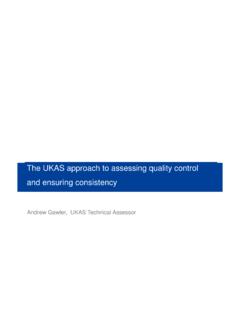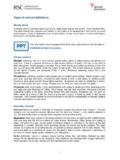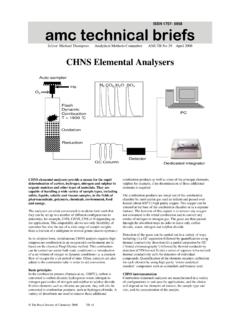Transcription of Internal quality control in routine analysis
1 issn 1757- 5958 amc technical briefs Editor: Michael Thompson Analytical Methods Committee AMCTB No 46 February 2010 amc Internal quality control in routine analysis Internal quality control (IQC) ensures that factors determining the magnitude of uncertainty do not change during the routine use of an analytical method over long periods of time. Together with validation, IQC forms the mainstay of quality practice in chemical analysis . Broadly speaking, validation comprises the estimation of the uncertainty of results resulting from the use of a method under given conditions. Analysts can then judge whether the method is fit for purpose by comparing that uncertainty with the end-users requirements.
2 Internal quality control (IQC) is a process for checking that the uncertainty at validation does not deteriorate after validation, that is, when the method is in routine use. IQC is conducted by inserting one or more control materials into every run of analysis . The control materials are treated by an analytical procedure identical to that performed on the test materials. The results are plotted on control charts, which are interpreted in the usual fashion simple! Well, not entirely simple. There are factors that need careful consideration if the IQC system is to represent the routine analytical operation adequately. But first the good news. IQC is already traceable via the validation process. Its only purpose is to check that the analytical system has not changed since validation.
3 Like all statistical control , IQC operates on the basis of the mean result and standard deviation of the analytical process. Measures to address the quality of quality control itself comprise a significant gap in the management of data quality Within-run precision At this point we have to consider the exact meaning of the word run . A run is a set of test materials that is analysed under repeatability conditions, that is, within a short time . Within a run, there should be no changes in the magnitude of errors. However, repeatability in that sense is an ideal that is never realised. There are always systematic changes within a run, however short the time span from the first to the last analysis . So in practice we have to settle for negligible change rather than no change.
4 We can do that by treating repeatability conditions and run as mutually defining. For example, a run could comprise a sufficient number of test materials to provide three hour s continuous analysis . We then treat the variations within the run as random and attribute them to repeatability. Between-run ( intermediate ) precision Internal quality control , however, is based on between-run precision, closeness of agreement between results obtained in separate runs of analysis . This necessarily has a greater dispersion than within-run precision, owing to an additional source of error affecting individual runs differently. This addition source is introduced by uncontrolled changes such as those brought about by a change of analyst, new reagents, recalibration and changes in the laboratory environment.
5 To estimate between-run standard deviation in an unbiased manner, the control materials have to be placed at random positions in the analytical sequence of the run. If for example the control materials were always first in the sequence, they would be analysed just after the instrument had been calibrated, with little time for systematic changes to manifest. The replicated results would consequently tend to underestimate the between-run standard deviation.* Setting control limits Most textbooks tell us that control limits are determined by the parameters ( ,) of the controlled process. However, we never know the parameters: we know only the corresponding statistical estimates ),(sxcalculated from replicated results. This distinction has important implications that are often overlooked, and it makes setting up the control chart a little trickier than might be expected.
6 Firstly, to obtain a realistic estimate of between-run standard deviation, the measurements must be replicated in successive runs. The whole analytical system has to be set up from scratch each time, for example by switching on equipment from cold, renewing reagents, recalibrating etc, as appropriate. The control materials should be handled as ordinary test materials would be in routine analytical operations, that is, interspersed among a number of test materials. That would be impracticable as part of validation per se (it could take several weeks) and is necessarily conducted when routine operations are already underway. The practical strategy is therefore to start routine operations with a provisional control chart. Such a chart could be based on the repeatability statistics (r) readily established during validation, but with control lines wider than usual, at (say) rand rfrom the mean.
7 (This would reflect the observation that between run standard deviation is often about r.) control lines at rand rwould be too narrow, resulting in an excessive number of out-of- control sx, * It is often prudent to run a check solution at the beginning of a run to ensure that the calibration was carried out correctly, but that type of checking must be distinguished from IQC. IQC TB v4 23/02/10 The Royal Society of Chemistry 2010 events.) Alternatively, temporary control lines based on fitness-for-purpose considerations could be used. After sufficient runs and replicated results have been collected from the analysis of the control materials, estimates of the between-run statistics can be used to set up the control chart.
8 However, this is not completely straightforward. Firstly we have to recognise that a newly adopted method is prone to produce results that are more erratic than those from a familiar one. Early results may be atypically error-prone and might need to be discarded before we estimate the standard deviation. In any event, a robustified procedure is recommended to avoid undue influence from outlying results. The second problem is that we need a surprisingly large number of results to obtain a stable estimate of standard deviation, and the control lines that depend on it. For example, if we were to collect the usual 10 results there would be a 10% probability that the estimated standard deviation would deviate from its true value by more than 40% (under the assumption of independence and normality).
9 The control limits, therefore, have to be reviewed after a greater number of results have accumulated. Choosing the control material(s) The best materials for IQC are typical examples of the routine test materials, assuming that they are sufficiently stable for the purpose. The control materials do not have to be expensive certified reference materials (CRM). Indeed it is often better if they are not it is seldom possible to procure a CRM exactly matching the matrix of the test materials. Well-matching control materials, however, can be prepared in large amounts in-house, so that the continuity of the control system can remain unbroken for a long period. control materials will not be identical with the test material, because in all likelihood they will have to be more finely divided to ensure a close approach to homogeneity before use, and may need further processing ( , dehydration) to ensure stability.
10 This may mean that the control material behaves slightly differently. For instance, a control material might be more (or possibly less) completely decomposed than a typical test material during the analytical treatment. The difference is unlikely to be important because, as we have seen above, IQC tests for consistency after validation rather than absolute accuracy. Number and proportion of control materials In many instances the range of concentrations of the analyte encountered in test materials will be relatively small, and in such cases a single control material is appropriate, with the analyte in mid-range. If the analysis is for testing the material against a legal or contractual limit for some constituent, the analyte concentration should be near that limit.










